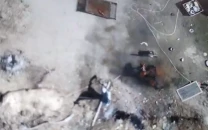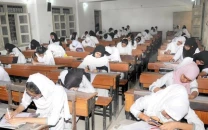How to check rural to urban mobility
Speakers at Alliance Francais discussed the phenomenon and how it is dealt with

Olivier Mongin. PHOTO: www.afkarachi.com/
This fact baffled the audience at the Alliance Francais when it was highlighted by Olivier Mongin, vice-president of the French Union for cultural and scientific press and the editorial director of the journal Esprit. He was speaking at a session titled 'Multifaceted and Splintered Urban Globalisation' on Tuesday.
According to Mongin, the Hukou System effectively limits rural-urban migration. He said that in China only internal resident permit holders have the right to health and other civic facilities, which workers from rural areas cannot avail. The rural population needs a 'Hukou' to reside in urban areas, he said.
"After working hours, they are obliged to leave the city," he said, adding that the Chinese example is an extreme form of controlling urbanisation. However, similar cases have been seen in Dubai and Singapore, where there is a division between residents with full rights and residents with only working rights. Even in Sudan, workers live in camps controlled by the government, according to Mongin.
He said there are three phases of urbanisation: First when Europe discovered America, second when, due to industrialization, mass urbanisation took place and the third is the current urbanisation that has emerged due to mobility, which he referred to as 'neo mobilisation'.

Mongin said the real issue was that of mobility. "If you don't have road networks, parks and water facilities, what use could there be of providing houses?" he asked, criticising NGOs who give priority to houses over infrastructure.
He said that the problem with NGOs is that they have to satisfy their donors. "Circulating a photo of a house is better than circulating a picture of an empty field for NGOs," he reasoned.
He gave the example of France as a welfare state where violence erupted because housing was provided without jobs or education facilities. "If you provide housing without such facilities, you invite violence," said Mongin.
Speaking more about France, he said that urbanism was completely linked with functionalism and utility services, like houses and streetlights in France. However, now the concept of utility services was fading away and everything was being linked with mobility. Mobility for work and mobility for recreation, he said that mobility was now needed for everything.
Migration and Karachi
NED University's department of architecture and planning chairperson, Prof Dr Noman Ahmed, spoke on the migrations that Karachi has experienced so far.
He said that first mass migration to the port city was at the time of independence in 1947 and second was during 1950s when the military government announced agricultural reforms and brought about industrialisation, thereby encouraging the rural population to migrate to urban areas. The third migration was in 1971 when Pakistan was split into two states, Pakistan and Bangladesh. The fourth migration, according to him, occurred due to conflict in Afghanistan and the fifth is the current migration Karachi is facing due to the war against terrorism.
Every migration, according to Dr Ahmed, has brought social and cultural changes, which became increasingly evident over the time. "Conflicts are now settled by muscle power," he said. "Tribalism is increasing very fast."
He said that in 1960s and 1950s the city was managed by a municipal organisation, which was later taken up by informal sectors. For example, he said that public transport for many decades has been operated by the informal sector in Karachi that had no direct link with the state. "The state took a back seat and housing fell to the informal sector," he explained.
Published in The Express Tribune, October 8th, 2015.



















COMMENTS
Comments are moderated and generally will be posted if they are on-topic and not abusive.
For more information, please see our Comments FAQ